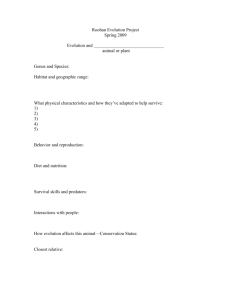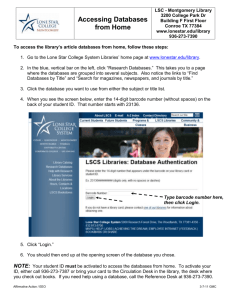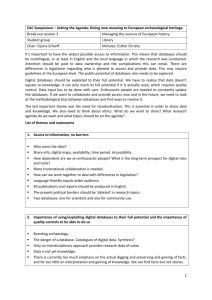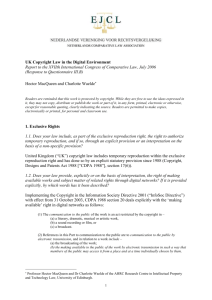Databases & Copyright
advertisement
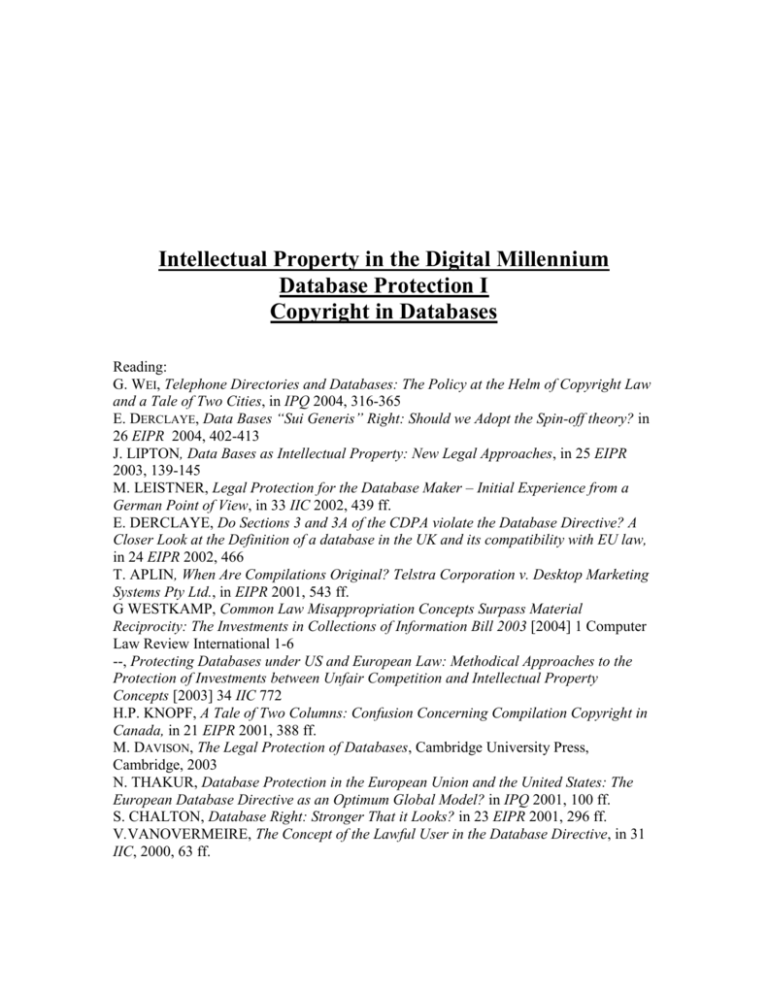
Intellectual Property in the Digital Millennium Database Protection I Copyright in Databases Reading: G. WEI, Telephone Directories and Databases: The Policy at the Helm of Copyright Law and a Tale of Two Cities, in IPQ 2004, 316-365 E. DERCLAYE, Data Bases “Sui Generis” Right: Should we Adopt the Spin-off theory? in 26 EIPR 2004, 402-413 J. LIPTON, Data Bases as Intellectual Property: New Legal Approaches, in 25 EIPR 2003, 139-145 M. LEISTNER, Legal Protection for the Database Maker – Initial Experience from a German Point of View, in 33 IIC 2002, 439 ff. E. DERCLAYE, Do Sections 3 and 3A of the CDPA violate the Database Directive? A Closer Look at the Definition of a database in the UK and its compatibility with EU law, in 24 EIPR 2002, 466 T. APLIN, When Are Compilations Original? Telstra Corporation v. Desktop Marketing Systems Pty Ltd., in EIPR 2001, 543 ff. G WESTKAMP, Common Law Misappropriation Concepts Surpass Material Reciprocity: The Investments in Collections of Information Bill 2003 [2004] 1 Computer Law Review International 1-6 --, Protecting Databases under US and European Law: Methodical Approaches to the Protection of Investments between Unfair Competition and Intellectual Property Concepts [2003] 34 IIC 772 H.P. KNOPF, A Tale of Two Columns: Confusion Concerning Compilation Copyright in Canada, in 21 EIPR 2001, 388 ff. M. DAVISON, The Legal Protection of Databases, Cambridge University Press, Cambridge, 2003 N. THAKUR, Database Protection in the European Union and the United States: The European Database Directive as an Optimum Global Model? in IPQ 2001, 100 ff. S. CHALTON, Database Right: Stronger That it Looks? in 23 EIPR 2001, 296 ff. V.VANOVERMEIRE, The Concept of the Lawful User in the Database Directive, in 31 IIC, 2000, 63 ff. - Effects of skill and labour copyright o Categorisation o Infringement o Unfair competition o Misappropriation - International background; protection of original databases; initial scope in Art 10 (2) TRIPs and 2 (5) BC; national approaches: skill and labour; creativity; uncertainty o Feist decision (499 US 340 o Problem of copyright/information freedom: resolved by limited protection for original arrangement o Information protection – Lockean approaches and approaches based on mixing of pre-existing goods o Existing role models – Scandinavian catalogue rule; Dutch protection of unoriginal writings (catalogues and the like); unfair competition (problem: behaviour based approaches and additional requisites; see Article 10bis (3) Paris Convention - The 1996 database Directive o Based on Article 95 EC – Articles 30, 57 (2) – goals under Article 8a EC (internal market; reduction of obstacles) o 1988 Green Book o Commission Initiatives – copyright consolidation plus ‘unfair extraction’ right o Final version – two tier system – copyright and SGR - Object of protection/compromise between UK/continental approaches o Database (Article 1 (2) DD = Collection of information and other data Contents Independent elements Structured systematically o excluded works and subject matter works contained sound recordings computer programs (problem: is a computer program a database?; can a database contain a computer program?; what about collections of computer programs?) – investment in software may suffice Index, thesaurus are protected Copyright Protection Subject Matter o Berne approach – must be own intellectual creation ‘own’ Minimum requirements (cf computer generated works/databases??) – creativity – independent creation Selection and/or arrangement Comprehensive database – but term is relative Examples for sufficient selection: ‘best’ restaurants etc. Arrangement means structure of items in database (not to be confused with ‘systematic structure under definition). o skill and labour vs. creativity. Sec. 3A CDPA now raises standard German approach (“striking distance from everyday creations – Debt Collection decision 1985) UK – RAISED STANDARD IN SEC. 3a coda – CONTINUEDE APPLICATION OF SEC. 3. Rights Conferred and Ownership - Reproduction, Art 5 o Temporary Reproductions (relationship computer program copyright – databases – first proposal for EUCD, Art 2 (e) o RAM Copies o Copies on Routers and Proxy Servers – the three step test as role model?? - adaptations (Art 12 BC) - translation - public distribution and rental (not lending) - exhaustion – status of exhaustion in EC law – purpose – physical carriers. - Public communication, performance - In particular making available right (Art 8 WCT; 10 WPPT; 3 EUCD) o Making available o Communication to o The public o And reproductions?? - Ownership o General national rules apply Copyright Limitations - Art 6 – public policy and lawful user o Art 6 (1) – lawful user may exercise any act necessary for access to database and normal use of contents – issue of ‘lawful user’ o Art 6 (2): reproductions for scientific and research purposes; traditional existing limitations, Art. 6 (2) (e) o No private copying




